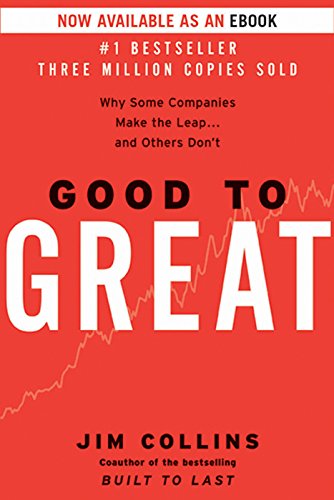

This article is an excerpt from the Shortform summary of "Good to Great" by Jim Collins. Shortform has the world's best summaries of books you should be reading.
Like this article? Sign up for a free trial here .
What are the key takeaways from Good to Great by Jim Collins? How does Collins believe good companies can become great ones?
We’ll cover the most important key takeaways from Good to Great. Whether you’re an entrepreneur, a manager, or just an individual looking to improve, the concepts in Good to Great provide food for thought—and spurs to action. You’ll learn what it takes to be a “Level 5” leader, why assembling the right team first is more important than having the right idea, and why you should be more like a hedgehog than a fox.
What Are the Key Takeaways from Good to Great?
Before we dive into the key takeaways from Good to Great, we need some context. What is Good to Great about?
At a dinner Collins was attending in 1996, a McKinsey managing director pointed out a flaw in Built to Last, Collins’s 1994 bestseller that explained how long-lasting companies achieved their success. The flaw was that the companies Collins studied were, for the most part, always unique—they never had to make the leap from just good to great.
Thus the idea for Good to Great was born: to study whether good companies can indeed become great companies and, if so, how they can. This led to the key takeaways from Good to Great.
Over five years, Collins’s team of 21 researchers reviewed close to 6,000 articles and generated over 2,000 pages of interview transcripts to determine whether and how companies can go from good to great.
9 Key Takeaways from Good to Great
In the process of analyzing and coding the various facets of the good-to-great companies and their comparisons, Collins and his team were clued into key concepts by a number of surprising differences.
- Good to Great Key Takeaway #1: High-profile, celebrity CEOs brought in from the outside to whip a company into shape actually hurt a company’s ability to transition from good to great.
- Good to Great Key Takeaway #2: “Strategy”—that is, the formulation of a long-term plan of any kind—didn’t correlate with good-to-great. Both the good-to-great companies and the comparison companies had long-term strategies in place.
- Good to Great Key Takeaway #3: Technology was insignificant as far as starting a transition from good-to-great. It helps hasten a transformation, but isn’t required for a transformation to begin.
- Good to Great Key Takeaway #4: Mergers and acquisitions were not a cause of greatness.
- Good to Great Key Takeaway #5: Good-to-great transformations weren’t highlighted by a press release, announcement, rollout, or anything at all. Rather, they were the result of steady, dogged work that, to observers inside the company and out, seemed perfectly ordinary—even boring.
- Good to Great Key Takeaway #6: The particular industry wasn’t important: Some good-to-great companies specialized in unglamorous areas yet were able nevertheless to produce great results.
So how did the good-to-great companies do it? Collins provides a tidy chronological diagram that details the companies’ unique traits. The diagram constitutes one of the key takeaways from Good to Great.
Good to Great Key Takeaway #7: Buildup Phase
- People
- Level 5 Leadership: Good-to-great companies are led by “Level 5” leaders—personally humble but professionally driven executives.
- The Right Team: Having the right people on board early pays dividends down the line.
- Thought
- Facts Over Fantasy: Companies need to develop a culture where brutal truth is heard (but hope springs eternal).
- Facts Over Fantasy: Companies need to develop a culture where brutal truth is heard (but hope springs eternal).
Good to Great Key Takeaway #8: Breakthrough Phase
- Hedgehog Thinking: To think like a hedgehog, rather than a fox, is to develop a simple guiding concept for your organization.
- Action
- Disciplined Culture: The organization from top to bottom needs to understand and adhere to the “Hedgehog Concept.”
- Tech Done Right: Good-to-great companies never latch onto new technology for its own sake. They use tech to accelerate transitions, not create them.
Good to Great Key Takeaway #9: To head off the notion that these features can be implemented or cultivated overnight, Collins and his team came up with the “flywheel” analogy. A heavy flywheel takes an enormous amount of energy to get going—but once it’s spinning, it only takes a small amount of energy to keep it turning or to increase its speed. Good-to-great companies achieve their key strengths steadily and doggedly; they stay patient in the confidence that, with the right cogs in place, the breakthrough will come. This is a key takeaway from Good to Great.
The opposite of the flywheel is the “doom loop.” A company that tries to revolutionize its strategy, culture, product, or process in one fell swoop is fated to fail.
Methods of Good to Great
To understand why the key takeaways from Good to Great are so important, we need to understand how Jim Collins got his data. Collins’s criteria for a good-to-great company was as follows:
- A fifteen-year stock return at or below the general market return; followed by
- A transition point; resulting in
- Fifteen-year cumulative returns at least 3x the general market return.
The team chose fifteen years as the default scale for two reasons:
- It’s long enough to rule out lucky breaks or one-offs; and
- It exceeds the average CEO’s tenure, thereby mitigating the singular effects of a particular leader.
Meanwhile, the team chose the 3x stock-return metric because it exceeded the returns posted by companies commonly thought of as great (Intel, Boeing, Walt Disney, etc.).
Collins and his team found 11 companies that satisfied the criteria. The answer was yes: companies could go from good to great. This idea would influence the key takeaways from Good to Great. But how did these companies make the jump?
To determine what set these 11 companies apart from their competition, Collins and his team compiled a list of “comparison companies.” Each comparison company
- Competed in the same industry as its relative good-to-great company;
- Possessed similar resources and opportunities as its good-to-great company; and
- Featured a fifteen-year stock return at or below the general market return that remained at that level after the good-to-great company’s transition point.
The Companies
To understand the key takeaways from Good to Great, let’s look at the companies Collins and his team studied. The 11 companies are listed below. Comparison companies are in parentheses, followed by the companies’ industries.
- Abbott (Upjohn) – Health Care
- Circuit City (Silo) – Retail
- Fannie Mae (Great Western) – Financial Services
- Gillette (Warner-Lambert) – Consumer Goods
- Kroger (A&P) – Retail
- Nucor (Bethlehem Steel) – Steel
- Philip Morris (R. J. Reynolds) – Tobacco
- Pitney Bowes (Addressograph) – Business Services
- Walgreens (Eckerd) – Pharmacy
- Wells Fargo (Bank of America) – Banking/Financial Services
In addition to direct comparisons with statically good companies, Collins and his team compared the good-to-great companies with companies that showed great results but couldn’t sustain them over the fifteen-year window (“Unsustained Comparisons”). Those companies are:
- Burroughs – Business Services
- Chrysler – Automotive
- Harris – Aerospace and Defense (previously Business Services)
- Hasbro – Toys/Entertainment
- Rubbermaid – Manufacturing
- Teledyne – Conglomerate (Electronics, Aerospace and Defense)
Once Collins and his team had determined the good-to-great companies and their comparisons, they compiled and coded material related to each company’s strategy, technology, leadership, culture, compensation structure, and management turnover. They also conducted interviews with the executives who presided over the various companies at the transition point.
———End of Preview———

Like what you just read? Read the rest of the world's best summary of "Good to Great" at Shortform . Learn the book's critical concepts in 20 minutes or less .
Here's what you'll find in our full Good to Great summary :
- The 3 key attributes of Great companies
- Why it's better to focus on your one core strength than get spread thin
- How to build a virtuous cycle, or flywheel effect, in your business






